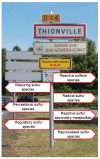The Reactive Sulfur Species Concept: 15 Years On
- PMID: 28545257
- PMCID: PMC5488018
- DOI: 10.3390/antiox6020038
The Reactive Sulfur Species Concept: 15 Years On
Abstract
Fifteen years ago, in 2001, the concept of "Reactive Sulfur Species" or RSS was advocated as a working hypothesis. Since then various organic as well as inorganic RSS have attracted considerable interest and stimulated many new and often unexpected avenues in research and product development. During this time, it has become apparent that molecules with sulfur-containing functional groups are not just the passive "victims" of oxidative stress or simple conveyors of signals in cells, but can also be stressors in their own right, with pivotal roles in cellular function and homeostasis. Many "exotic" sulfur-based compounds, often of natural origin, have entered the fray in the context of nutrition, ageing, chemoprevention and therapy. In parallel, the field of inorganic RSS has come to the forefront of research, with short-lived yet metabolically important intermediates, such as various sulfur-nitrogen species and polysulfides (Sx2-), playing important roles. Between 2003 and 2005 several breath-taking discoveries emerged characterising unusual sulfur redox states in biology, and since then the truly unique role of sulfur-dependent redox systems has become apparent. Following these discoveries, over the last decade a "hunt" and, more recently, mining for such modifications has begun-and still continues-often in conjunction with new, innovative and complex labelling and analytical methods to capture the (entire) sulfur "redoxome". A key distinction for RSS is that, unlike oxygen or nitrogen, sulfur not only forms a plethora of specific reactive species, but sulfur also targets itself, as sulfur containing molecules, i.e., peptides, proteins and enzymes, preferentially react with RSS. Not surprisingly, today this sulfur-centred redox signalling and control inside the living cell is a burning issue, which has moved on from the predominantly thiol/disulfide biochemistry of the past to a complex labyrinth of interacting signalling and control pathways which involve various sulfur oxidation states, sulfur species and reactions. RSS are omnipresent and, in some instances, are even considered as the true bearers of redox control, perhaps being more important than the Reactive Oxygen Species (ROS) or Reactive Nitrogen Species (RNS) which for decades have dominated the redox field. In other(s) words, in 2017, sulfur redox is "on the rise", and the idea of RSS resonates throughout the Life Sciences. Still, the RSS story isn't over yet. Many RSS are at the heart of "mistaken identities" which urgently require clarification and may even provide the foundations for further scientific revolutions in the years to come. In light of these developments, it is therefore the perfect time to revisit the original hypotheses, to select highlights in the field and to question and eventually update our concept of "Reactive Sulfur Species".
Keywords: cellular thiolstat; reactive sulfur species; redox signalling; redoxome.; sulfur radicals.
Conflict of interest statement
Authors declare no conflict of interest.
Figures






References
-
- Kuhn T.S. The Structure of Scientific Revolutions. 2nd ed. University of Chicago Press; Chicago, IL, USA: 1970.
-
- Read R., Bellew T., Yang J.G., Hill K.E., Palmer I.S., Burk R.F. Selenium and amino acid composition of selenoprotein P, the major selenoprotein in rat serum. J. Biol. Chem. 1990;265:17899–17905. - PubMed
Publication types
LinkOut - more resources
Full Text Sources
Other Literature Sources
Miscellaneous

